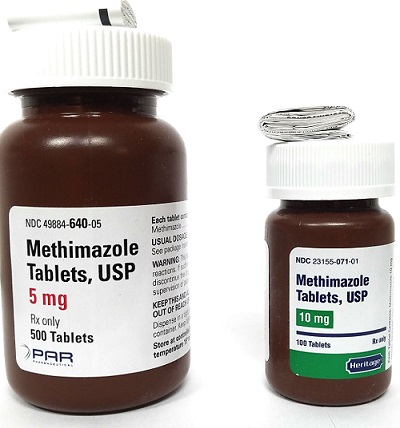Providing Quality & Trust || Clinic Website
Methimazole Tablet
No Info
Starting at $0.48
$0.48 Each
Detailed Description
Methimazole
(meth-im-a-zole)
- Description: Anti thyroid agent
- Other Names for this Medication: Tapazole®, Felimazole®
- Common Dosage Forms: Veterinary: 5 mg & 10 mg sugar-coated tablets. Topical gels may be available from compounding pharmacies.
Key Information:
- Used to lower the amount of thyroid hormones in animals.
- Available in different dosage forms, including a topical gel.
- Pregnant women or women who may become pregnant, nursing mothers, and people with low thyroid hormones should avoid handling methimazole.
- Most side effects (eg, vomiting, decreased appetite, or lethargy [tiredness; lack of energy]) occur in the first 3 months of therapy. Side effects may improve with a temporary, lower dose with gradual increase to desired dose.
Prescriber Highlights:
- Used in the treatment of feline hyperthyroidism
- Has a bitter taste if uncoated or cut/crushed tablets are administered
- Transdermal methimazole gels can be considered in cats that do not tolerate oral administration.
- The Contraindications/Precautions/Warnings section should be reviewed before prescribing.
- Adverse GI effects occur most commonly in the first 3 months of therapy and are usually transient. Adverse hematologic or hepatic effects and facial excoriations may require discontinuation of therapy.
- Nursing should not be allowed for queens receiving methimazole; kittens should be placed on a milk replacer.
- The National Institute for Occupational Safety and Health (NIOSH) classifies methimazole as a hazardous drug; use appropriate precautions when handling.
How is Methimazole used?
Methimazole is given to lower thyroid hormone levels.
It is important to understand that methimazole does not cure an overactive thyroid but controls the disease if given to the animal for the rest of its life.
Veterinarians may also prescribe methimazole for dogs to protect their kidneys while they are receiving cisplatin chemotherapy.
- The FDA has approved this drug for treating hyperthyroidism in cats.
- The FDA allows veterinarians to prescribe and use products containing this drug in other animal species in certain situations.
You and your veterinarian can discuss why this drug is the most appropriate choice.
Uses/Indications:
Methimazole is considered by most clinicians in North America to be the drug of choice to treat feline hyperthyroidism. More than 90% of cats that tolerate methimazole respond to the drug. Propylthiouracil has a significantly higher incidence of adverse effects as compared with methimazole and is rarely used. In a retrospective case series, iodine 131 was more effective than methimazole in the treatment of hyperthyroid cats, and cats treated with iodine 131 had a survival time of 4 years as compared with 2 years for those treated with methimazole and 5.3 years in those that received methimazole followed by radioiodine.
Transdermal methimazole (in pluronic lecithin organogel [PLO]) has been used with some therapeutic success in cats that cannot tolerate oral administration. Four or more weeks of therapy may be required for the drug to reach efficacy. Orally administered methimazole is more effective than transdermal methimazole.
What are the side effects of this medication?
Methimazole is usually well tolerated, but side effects can occur; most happen in the first 3 months of therapy.
- Common but not serious side effects:
- Vomiting.
- Decreased appetite or loss of appetite.
- You do not have to be overly concerned if you see any of these signs unless they are severe, are persistent, or worsen.
Contact your veterinarian if this happens.
- Side effects that may be serious or indicate a serious problem:
- Fever.
- Bruising.
- Depression, lethargy (lack of energy).
- Severe weakness (rare).
- Itching and scratching (particularly of the face) to the point that the animal causes bleeding.
- Sores (rare).
If you see any of these signs, contact your veterinarian immediately.
Precautions/Warnings:
Methimazole is contraindicated in patients that are hypersensitive to it, carbimazole, or the excipient, polyethylene glycol. The US veterinary label states that methimazole is contraindicated in cats with autoimmune disease, primary liver disease, renal failure, or hematologic disorders (ie, anemia, neutropenia, lymphopenia, thrombocytopenia) or coagulopathies; the UK veterinary label also states, Do not use in cats suffering from systemic disease such as primary liver disease or diabetes mellitus. Cats with liver disease can potentially receive the drug at lower doses with dose titration and liver function tests intensely monitored.
Treatment of hyperthyroid cats with methimazole can unmask underlying renal disease because lowering thyroid hormone levels decreases glomerular filtration rates. As such, the cat’s renal parameters should be monitored closely during treatment (see Monitoring). In a study, significant reduction in serum creatinine was noted after restoration of euthyroidism in cats with iatrogenic hypothyroidism caused by methimazole or carbimazole.
In another study, an increasing prevalence of moderate-to-severe thyroid disease (eg, large thyroid tumors, multifocal disease, intrathoracic thyroid masses) was associated with an increased duration of methimazole treatment, which the authors speculated may indicate a progressive nature of feline hyperthyroidism that is not stopped by maintaining euthyroidism with methimazole.
Methimazole has antivitamin K activity, which may increase risk for bleeding.
The National Institute for Occupational Safety and Health (NIOSH) classifies methimazole as a hazardous drug representing an occupational hazard to healthcare workers; wash hands after handling and use personal protective equipment (PPE) accordingly to minimize the risk for exposure.
Methimazole should not be confused with methAZOLamide or metOLAZone.
If you have any other questions about this medication, contact your veterinarian or pharmacist.

Powered by nopCommerce
This site is running in live payment mode. Real payments will be processed.

